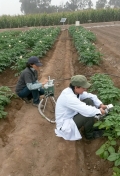CIP
No-one knows exactly when potatoes arrived in Central Asia. Native to South America, early European traders brought the tuber east. By the late 17th century contemporary accounts suggest that the crop was well established in India and China. A century later, it was being cultivated...
Frente al gran desafío que significa producir papa en zonas áridas, el Centro Internacional de la Papa (CIP) está trabajando simultáneamente en dos frentes. La primera línea de estudio es una técnica denominada ...
While potato industry officials say 2015 was a slower year for sales of fresh Maine potatoes, one variety did buck the trend — red potatoes.
Of the more than 20 varieties of potatoes planted by growers across the state, the russet burbank is the most popular. Known as a dry,...
Have you exhausted all the more than 3,000 varieties of potatoes and are ready for a new flavor? It looks like new varieties are headed our way!
The National Agricultural Innovation Program (NAIP), the National Institute of Agrarian Innovation...
As stated in a recent Fun Fact Friday article about potatoes, the tasty tubers might be grown all over the world today, but they originated in Peru between 7,000 and 10,000 years ago....
When we finally get people to Mars to live and form a colony, what will they eat? Eventually these pioneers will have to move away from the supplies they take with them from Earth and start to grow their own food in the Red Planet’s soil. In the movie "The Martian," partly famed for...
They are more associated with spying, but unmanned aerial vehicles (UAVs or drones), will soon be deployed in Uganda to help farmers increase agricultural output and enhance food security.
A drone is operated using a remote control and flies using propellers. It can be fitted...
In the hit movie, “The Martian”, NASA astronaut Mark Watney survives by planting potatoes in one of the modules of the ...
La iniciativa Chirapaq Ñan fue lanzada en 2012 con el objetivo de monitorear sistemáticamente la alta diversidad de papas nativas y el estado de conservación de las variedades a lo largo del tiempo y en su ambiente natural (in-situ). Chirapaq Ñan es quechua de la Cordillera Central de...
Compartimos este boletín que los amigos del Proyecto Chirapaq Ñan y el Centro Internacional de la Papa (CIP) nos han hecho llegar. En esta quinta edición se presenta los sigueintes temas:
- Actividades de la iniciativa en los diferentes microcentros y las labores de los...








